Auger drilling of wells: features of technology and a tool for drilling manually and using an installation
Auger drilling of wells for drinking water is the most popular method of drilling today on the territory of private households. You can make a shallow water-bearing well yourself using a hand-held earth drill. To make work easier, small-sized drilling rigs with a drive are often used.
We'll tell you why this method is so popular. Let’s look at how it differs from other drilling methods and in what situations it is effective to use. The article describes in detail auger technology and the design of drilling equipment, as well as drilling tools used in manual and mechanical drilling.
The content of the article:
Specifics of auger drilling
A borehole is a cylindrical excavation in the earth's crust, which, despite its large extent, has a small cross-section. Its beginning is called the mouth, the side surface is called the walls, and the bottom of the excavation is called the face.
The optimal drilling method is chosen taking into account the functional purpose of the well, the required diameter and depth. It is important to take into account the physical and mechanical properties of the rocks that must be passed through in the process of forming a water intake excavation.
The technical and economic feasibility of drilling in specific conditions also influences. This is a significant stage in well design, during which basic technological solutions are determined - the type of equipment used and drilling modes.
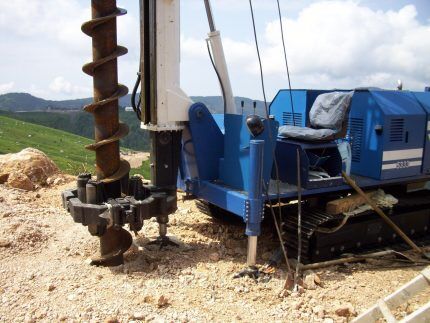
When designing and subsequently drilling water intake wells, it is necessary to focus specifically on long-term use. The ability to maintain a stable flow rate and constant water permeability of the bottomhole zone over a long period of time is important.
The well drilling process includes several work steps:
- The destruction of rock at the face, that is, the separation of particles from the massif.
- Transportation of waste soil to the surface.
- Preparing a well for operation by cleaning and equipping the wellbore, as well as washing the water intake shaft.
The efficiency of drilling directly depends on the physical and mechanical properties inherent in nature, namely: bulk density, porosity, water permeability of non-cohesive soils, and the consistency of clayey cohesive rocks.
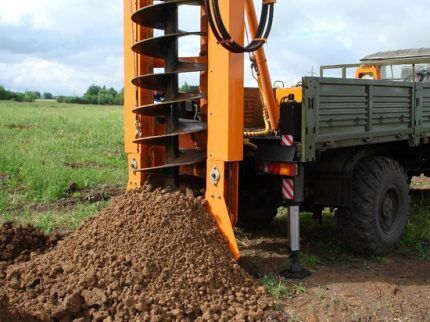
This method is not suitable for drilling rocks characterized by solidity and crystalline type of connections between particles. The more firmly the mineral grains are consolidated in the rock, the more work is spent on its destruction.
Advantages and disadvantages of the method
The auger drilling option is used in industry, civil engineering, and manual drilling of wells. Its distinctive feature is the removal of destroyed rock not with washing liquid or special gas-liquid mixtures, but directly with the parts of the auger projectile.
There are vertically and horizontally directed auger drilling. The first method is used when constructing water-bearing wells, as well as for forming holes for piles. The second is used when laying utilities using a trenchless method.
This method simultaneously provides high speed of penetration in non-rocky soils to a depth of 50-80 meters, allowing you to immediately form the walls of the excavation by installing a casing string.
Another plus is the extraction of waste soil to the surface without lifting the tool. And one more thing: since auger drilling does not require flushing fluid, it is successfully used in waterless regions, and is also used during periods when low temperatures predominate.
Today drilling with auger units is used:
- For the installation of individual water wells;
- When constructing foundations from screw/bored piles;
- For installation of fences and reinforced concrete supports;
- When performing trenchless installation of communications;
- For the construction of shallow wells and pits.
However, there are also disadvantages. It is impossible to drill a well with augers in rocks of high hardness. When drilling in hard and semi-solid loams, clays with layers of limestone, complications may arise, and when drilling abrasive rocks, there is a high consumption of drilling equipment.
In addition, there is a limitation on the depth of excavation.It is very difficult to construct a well more than 80 meters deep in this way.
Vertical tunneling technology
An auger is a high-strength drill pipe with a wound spiral, which serves as a vertical screw conveyor. Under the influence of an axial load, the working part of the drill bit penetrates the rock and destroys it by cutting and loosening. At the same time, the auger drill feeds the waste soil onto the auger spiral.

Under the influence of centrifugal forces, loosened soil rises upward along the blades of the drill string. The lifting occurs due to sliding in a spiral, since the friction of the soil on the auger is less than on the walls of the well.
Thus, the destroyed rock is delivered in a crushed state from the face to the surface and thrown out through the wellhead. With easy transportation, the soil fills 30-40% of the total volume of the interturn space.
The parameters of the auger column must ensure rapid lifting of the entire mass of soil destroyed by the auger. However, when drilling, part of the loosened soil falls back onto the bottom. Therefore, when performing auger drilling, more intensive cleaning of the barrel is required, and upon completion, mandatory flushing is required.
Horizontal directional auger drilling
When installing utility lines for various functional purposes under obstacles (highways, railways, forests), horizontally directed auger drilling is used.
At the initial stage of work, two pits are dug – a starting (working) pit and a receiving pit.They must be at the same level as the designed well. After this, the necessary equipment is lowered into the working pit and installed.
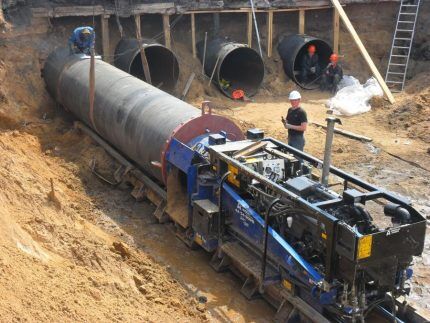
Such equipment has a large feed stroke and is equipped with a wear-resistant drill head made of high-alloy steel. It also has a drilling tracking probe installed. By receiving signals on the monitor, the operator controls the progress of the process and can adjust the direction of movement, as well as the angle of inclination of the drill head.
When the auger enters the receiving pit, that is, the end point according to the project, the drill is removed. Instead, the expander and pipe are fixed. After this, the blades are rotated in the opposite direction to pull the pipe into the finished well. At the end of the drilling work, the auger installation is removed from the starting pit.
The trenchless method makes it possible to lay pipes for communications below the groundwater level up to 80 m long. Moreover, all complex work is carried out without labor-intensive trenching, which makes it possible to minimize execution time and reduce financial costs.
Horizontal auger drilling is used when laying pressure pipelines and installing communication systems in areas where installation by other means is impossible. Main advantage trenchless installation – profitability. In addition, there is no need to use bentonite or other polymers to maintain the stability of the finished excavation.
Features of drilling in different rocks
The basic technological parameters of drilling a well are axial load and rotation speed of the screw conveyor. As the load increases, the speed of penetration certainly increases, which can lead to various emergency situations.
Therefore, it is imperative to ensure that the volume of rock separated per unit time by the auger does not exceed the productivity of the conveyor. Otherwise, plugs will form on the turns.
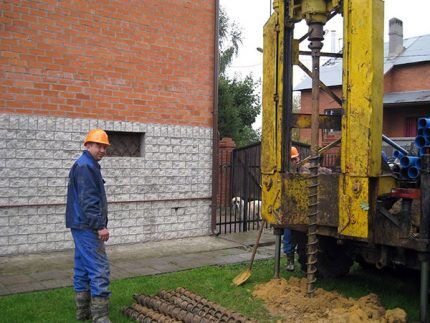
As a rule, plastic clay rocks, loose and medium-density sands are drilled without forced axial load. The auger tool is inserted into the ground under its own weight, as well as due to the reactive force that occurs when feeding waste rock to the mouth of a cylindrical opening.
Axial loads of up to 5 kN are usually created during initial drilling of a well, when drilling in hard sandy loams, loams, clays, mudstones, and siltstones. The rotation frequency of the column should not exceed 1.7-3.3 s-1.
At higher frequencies, vibrations occur internally, which can cause drill string links to become loose. As a result, the drill will remain at the bottom, it is almost impossible to get it out, which means you will have to drill a new working. And at low frequencies, transporting waste soil to the top becomes very difficult.
As rock hardness increases, axial loads increase.Drilling in gravel and grus-crushed soils, frozen loams, water-saturated sands, siltstones with quartz inclusions is carried out with an axial load of 8-10 kN per bit and a column rotation speed of 1.3-2.2 s-1.
Pebbles and rocks containing boulders are not drilled using the auger method. These rounded rock fragments are destroyed with a chisel and raised to the surface with a bailer.
Drilling in sands of varying density and degree of saturation with water, gravel and crushed stone deposits is carried out at high speeds and at the same time the walls of the excavation are strengthened with casing structures.

To avoid this, reduce the drilling speed to the minimum possible, walk the column and add water to the well. Also in such a situation, periodically raising the drilling tool to the surface and cleaning it from adhering loam helps.
Auger Drilling Tool
Tools for auger drilling of wells according to the type of design are distinguished by the number of turns and the geometry of the cutting part. For penetration in hard and semi-solid sandy loams and loams, drilling tools are often used, the edges of which are equipped with additional cutters.
Most often, for driving a water intake excavation for private owners, only one starting auger is used without any additions, because Sedimentary cohesive and non-cohesive rocks will need to be drilled. When deepening, the tool is simply extended with drill rods.
In this case, the projectile is removed from the wellbore every 0.5 - 0.7 m in order to clear the drill itself and the bottom of the destroyed rock. This is a more economical, but also more labor-intensive drilling option.
To drill out boulders and pebbles that can be found in sedimentary soils, they switch to the shock-rope method. As a rule, a chisel made of tool steel is used for this. This drill, pointed at the bottom end, is forcefully “thrown” onto the face until the “solid barrier” is destroyed.
After the destruction of a pebble or boulder, the fragments are removed to the surface using a glass (core pipe) or bailer. Then they switch to the screw method again. Most often, to excavate a mine, it is necessary to use several drilling methods in combination.
When drilling loose sand and soft loams, auger drills are used with blades turned toward the bottom at an angle of 30-60º, and for drilling in cohesive clayey rocks - 90º.
This spiral is obtained by winding a high-strength steel tape with a diameter of 5-7 mm onto a screw mandrel. It is stretched on a pipe/rod and then welded.
The larger the diameter of the base pipe, the lower the transporting capacity of the auger. However, the diameter of a long product is limited by the mechanical strength of the screw, as well as its production technology.
Today, two types of screws are manufactured:
- With a central hole, that is, hollow;
- Weighted - without hole.
To minimize wear on the screw conveyor when drilling in abrasive rocks, a strip of steel is screwed onto the outer edge or a layer of metal is fused to the surface.
At high auger drilling speeds, a special adapter with two-way winding of strip steel is fixed above the projectile. In this case, the bulk of the rock falls onto the screw conveyor without grinding.
At the end of the pipe with a wound spiral, the connection elements must be welded. There are two types of screw connections: threadless and threaded. In the first case, the screws are connected by coupling locks and held by metal pins with clamps; in the second case, by screwing.
Threaded connection of augers into a drill string makes it possible to mechanize their connection and disconnection when performing tripping operations and when supplying fluid to the face. But there is also a significant disadvantage - in this case there is no possibility of reverse rotation of the screws. Therefore, threadless connections have become more widespread.
Special drilling rigs usually include a set of augers of different diameters.
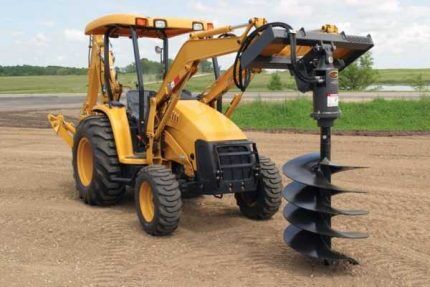
Hollow augers with a threaded type of connection are used when drilling with blowing, for pumping water when driving cylindrical openings in the earth's crust, for installing a charge in geophysical wells, for pumping concrete into holes for piles. They can also be used as casing.
When drilling with a continuous face, the central channel is blocked with a drilling tool on a rope.
Overview of drilling rigs
For auger drilling they use both hand tools, and mechanized installations. The simplest design is a hand-held earth drill.It consists of a rod/tube with a screw-shaped blade and a rigidly fixed T-shaped handle.
This type of drilling tool is screwed into the ground like a corkscrew. During the excavation process, it is expanded with rods. Hand-held earth drills are made collapsible to make them as convenient as possible for transporting them in passenger vehicles. This also allows you to change the length of the auger drill string.
Using hand tools, you can make holes up to 2 meters deep with a diameter of no more than 20 centimeters. There are also motor drills with gasoline or electric drive. Their design includes a screw conveyor, that is, an auger, and a motor with a gearbox. The rotation of the motor shaft ensures the movement of the auger.
With the use of a driven tool and the presence of drill rods for extension, it is possible to drill wells up to 25 meters deep. With a diameter of up to 30 centimeters, it is used for installing lighting poles on the street, for installing fence posts, pits for inspecting foundations, and soil foundations.
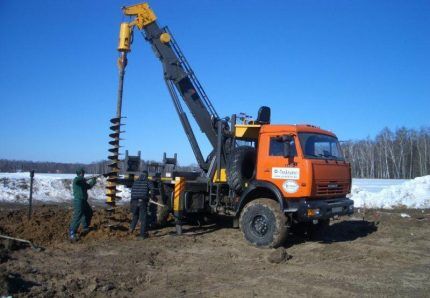
Mobile units are small machines with an electric or gasoline engine. With their help you can quickly drill well for a summer residence prepare a large number of holes for supports for various functional purposes.
Often such drilling rigs are made in the form of a trailer for passenger cars to facilitate transportation to the work site.
In civil and industrial construction, to form workings of great depth and diameter, special auger equipment is used, fixed on mobile equipment - trucks, tractors.
It is used when installing supports for high-voltage power lines and street lighting poles, when installing fence supports for stadiums, sports complexes, industrial facilities, and airfields. In addition, using auger drilling rigs on mobile equipment, they build sheet piling fencing for pits and install screw piles.
Useful video on the topic
Auger drilling of a water well 20 m deep on the territory of a private household:
This video shows the technology of horizontal auger drilling of a well for laying communications under a highway:
Installation of piles using a continuous large-diameter auger with a central channel. To carry out the work, a Bauer BG-30 drilling rig and a high-performance stationary Liebherr concrete pump are used:
The auger method provides high rates of well drilling. The development of the well and the supply of waste soil from the face to the mouth of the workings occurs simultaneously and continuously, which saves both the time and effort of the drillers, and the funds invested in the project. Therefore, the auger drilling method is popular.
Please leave comments in the block form below. Tell us if you have ever used a hand auger or drilled on a small drill rig using an auger. Share technological subtleties that may be useful to site visitors.

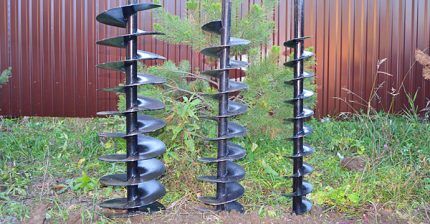




Auger drilling using technology is the best option for shallow wells.No wonder this method is popular. As for manual drilling with an auger, this is for masochists, or when there is no money at all, but the well is really needed.
I would like to get advice - I happened to have a hole drill for drilling under power line supports, based on a GAZ-66 car, I have an idea to adapt this unit for drilling wells for private individuals. The whole problem lies with the short length of the auger rods, because... the distance from the drive to the ground is somewhere around 1.2 m. The attractiveness of the idea is that. that the unit is mobile, all operations are feasible - rotation, lowering and raising, also reverse... Where can I order auger rods, please advise. Thank you.